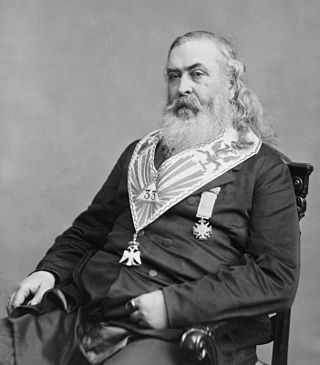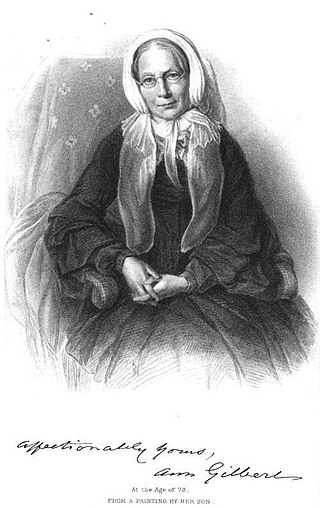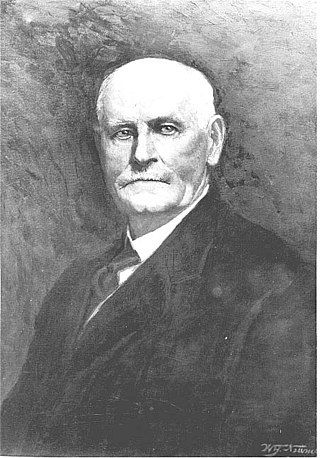Related Research Articles

Albert Pike was an American author, poet, orator, editor, lawyer, jurist and Confederate States Army general who served as an associate justice of the Arkansas Supreme Court in exile from 1864 to 1865. He had previously served as a senior officer of the Confederate States Army, commanding the District of Indian Territory in the Trans-Mississippi Theater. A prominent member of the Freemasons, Pike served as the Sovereign Grand Commander of the Supreme Council, Scottish Rite from 1859 to 1891.

Bryan Waller Procter was an English poet who served as a Commissioner in Lunacy.

Dorothy Mae Ann Wordsworth was an English author, poet, and diarist. She was the sister of the Romantic poet William Wordsworth, and the two were close all their adult lives. Dorothy Wordsworth had no ambitions to be a public author, yet she left behind numerous letters, diary entries, topographical descriptions, poems, and other writings.

The poem "In Memoriam A.H.H." (1850) by Alfred, Lord Tennyson, is an elegy for his Cambridge friend Arthur Henry Hallam, who died of cerebral haemorrhage at the age of twenty-two years, in Vienna in 1833. As a sustained exercise in tetrametric lyrical verse, Tennyson's poetical reflections extend beyond the meaning of the death of Hallam, thus, “In Memoriam” also explores the random cruelty of Nature seen from the conflicting perspectives of materialist science and declining Christian faith in the Victorian Era (1837–1901), the poem thus is an elegy, a requiem, and a dirge for a friend, a time, and a place.

Elizabeth Akers Allen, was an American poet and journalist. Her early poems appeared over the signature of "Florence Percy", and many of them were first published in the Portland Transcript. She came to Portland, Maine in 1855, and a volume of her fugitive poems appeared in that city just before her marriage to Paul Akers, the sculptor, whom she accompanied to Italy, and buried there. For several years, she was on the editorial staff of the Portland Advertiser. She wrote for most of the leading magazines, and several editions of her collected poems were published. She later resided in Ridgewood, New Jersey for several years.

Ann Gilbert was an English poet and literary critic. She gained lasting popularity in her youth as a writer of verse for children. In the years up to her marriage, she became an astringent literary critic. However, she is best remembered as the elder sister and collaborator of Jane Taylor.
"Annie Laurie" is an old Scottish song based on a poem said to have been written by William Douglas (1682?–1748) of Dumfriesshire, about his romance with Annie Laurie (1682–1764). The words were modified and the tune was added by Alicia Scott in 1834/5. The song is also known as "Maxwelton Braes".

The Young in Heart is a 1938 American comedy film produced by David O. Selznick, directed by Richard Wallace, and starring Janet Gaynor, Douglas Fairbanks Jr., and Paulette Goddard. The supporting cast features Roland Young and Billie Burke. This was Richard Carlson's feature film debut, preceding The Duke of West Point by a month.
"Monody on the Death of Chatterton" was composed by Samuel Taylor Coleridge in 1790 and was rewritten throughout his lifetime. The poem deals with the idea of Thomas Chatterton, a poet who committed suicide, as representing the poetic struggle.

"To Lord Stanhope" is a poem written by Samuel Taylor Coleridge. It was published in his 1796 collection of poems. The subject, Charles Stanhope, 3rd Earl Stanhope, had originally shared political views with Coleridge, but as time passed, Coleridge's views gradually shifted. By 1803, Coleridge was claiming that he did not want the poem published anymore and that it was originally intended to mock those who held the beliefs which Coleridge had held years earlier. It is part of the Sonnets on Eminent Characters series, although it was not published in the Morning Chronicle unlike the others in the series. There is, however, a possible predecessor sonnet to the 1796 version that some editors have attributed to Coleridge.
Bacchus and Ariadne is a poem by Leigh Hunt written and published in 1819. The result of three years of work, the poem tells the Greek myth of Hero and Leander, two lovers, and the story of their forlorn fate. Hunt began working on the poem during the summer of 1816, arousing the interest of the publisher John Taylor, and despite repeated delays to allow Hunt to deal with other commitments the poem was finished and published in a collection 1819. Hunt later claimed in a poem about Bacchus and Ariadne that he was seeking to humanise myths and make them more understandable to the common people. The collection was well received by contemporary critics and poets, including Thomas Carlyle, while more modern writers such as Edmund Blunden have criticised the flow of its narrative.
Jane Taylor was an English poet and novelist best known for the lyrics of the widely known "Twinkle, Twinkle, Little Star". The sisters Jane and Ann Taylor and their authorship of various works have often been confused, partly because their early ones were published together. Ann Taylor's son, Josiah Gilbert, wrote in her biography, "Two little poems – 'My Mother,' and 'Twinkle, twinkle, little Star' – are perhaps more frequently quoted than any; the first, a lyric of life, was by Ann, the second, of nature, by Jane; and they illustrate this difference between the sisters."

George Beattie was a Scottish poet.

John Trotwood Moore (1858–1929) was an American journalist, writer and local historian. He was the author of many poems, short stories and novels. He served as the State Librarian and Archivist of Tennessee from 1919 to 1929. He was "an apologist for the Old South", and a proponent of lynching.

Hattie Tyng Griswold was an American author of the long nineteenth century. She wrote many stories, sketches, and poems. Born in Boston, Griswold relocated with her family to Columbus, Wisconsin, in 1850, where, in the course of time, she married, raised her children, and did much of her work as an author. Her home was a meeting place of many of the notable people of the day, for she had an extensive personal acquaintance with literary and other celebrities. The books by which she is best-known are: Apple Blossoms, Waiting on Destiny, Lucile and Her Friends, and The Home Life of Great Authors. "Under the Daisies" is one of her best-known poems. She wrote stories for the Home Journal of New York, The Knickerbocker, Madison State Journal, Old and New, The Christian Register, and Boston Commonwealth. Griswold served as president of the Woman's Christian Temperance Union in her locale.
Emily Rebecca Page was an American poet and editor. She began contributing poems to the Portland, Maine Transcript in 1846. She wrote prose and poetry for the Carpet-Bag, Ladies' Repository, and the Rose-Bud. For several years, she was a contributor to the publications of Maturin Murray Ballou. Some of her poetry, including "The Old Canoe", was occasionally attributed to other authors. That and "Haunted" were printed in Poets and Poetry of Vermont. "The Old Bridge," "Mabel," "My Angels," and "Watching" were also well known. "Lily of the Valley" was issued in book-form. Page died in Massachusetts in 1862.

Susan Marr Spalding was an American poet of the long nineteenth century. Spalding was best known and least known by her poem, "Fate". The poem itself was widely copied and claimed, and its title was sometimes changed to "Kismet", but not until 1893 was Spalding's right of authorship absolutely settled.

The Marriage Whirl is a 1925 American silent drama film directed by Alfred Santell and written by Bradley King. It is based on the 1922 play The National Anthem by J. Hartley Manners. The film stars Corinne Griffith, Kenneth Harlan, Harrison Ford, E. J. Ratcliffe, Charles Willis Lane, Edgar Norton, and Nita Naldi. The film was released on July 19, 1925, by First National Pictures.

Sue A. Sanders was an American teacher, clubwoman, and author, who was prominent in charities and social circles. She served as national president of the Woman's Relief Corps, auxiliary to the Grand Army of the Republic, the largest charitable organization in the world in its day. She has the credit of being the originator of placing a flag in every school house, hers the first school to have a flag in McLean County, Illinois. The legislature changed the plan to putting it on the outside, which law was later repealed. She was the author of A journey to on and from the "golden shore" (1887).
"Time, Real and Imaginary. An Allegory" is a short poem of 11 lines written by Samuel Taylor Coleridge at an uncertain date, and first published in 1817.
References
- 1 2 3 Bob Taylor's Magazine 1910, p. 192.
- ↑ Moore 1905, p. 388.
- ↑ Carleton 1876, p. 223-24.
Bibliography
 This article incorporates text from this source, which is in the public domain :Bob Taylor's Magazine (1910). Bob Taylor's Magazine. Vol. 11–12 (Public domain ed.). Taylor's Publishing Company.
This article incorporates text from this source, which is in the public domain :Bob Taylor's Magazine (1910). Bob Taylor's Magazine. Vol. 11–12 (Public domain ed.). Taylor's Publishing Company. This article incorporates text from this source, which is in the public domain :Carleton, G. W. (1876). Record of the Year: A Reference Scrap Book. Vol. 2 (Public domain ed.). G. W. Carleton and Company.
This article incorporates text from this source, which is in the public domain :Carleton, G. W. (1876). Record of the Year: A Reference Scrap Book. Vol. 2 (Public domain ed.). G. W. Carleton and Company. This article incorporates text from this source, which is in the public domain :Moore, John Trotwood (1905). Trotwood's Monthly, Devoted to Farm, Horse, and Home. Vol. 1, Issue 3 - Volume 3, Issue 3 (Public domain ed.). Trotwood Publishing Company.
This article incorporates text from this source, which is in the public domain :Moore, John Trotwood (1905). Trotwood's Monthly, Devoted to Farm, Horse, and Home. Vol. 1, Issue 3 - Volume 3, Issue 3 (Public domain ed.). Trotwood Publishing Company.